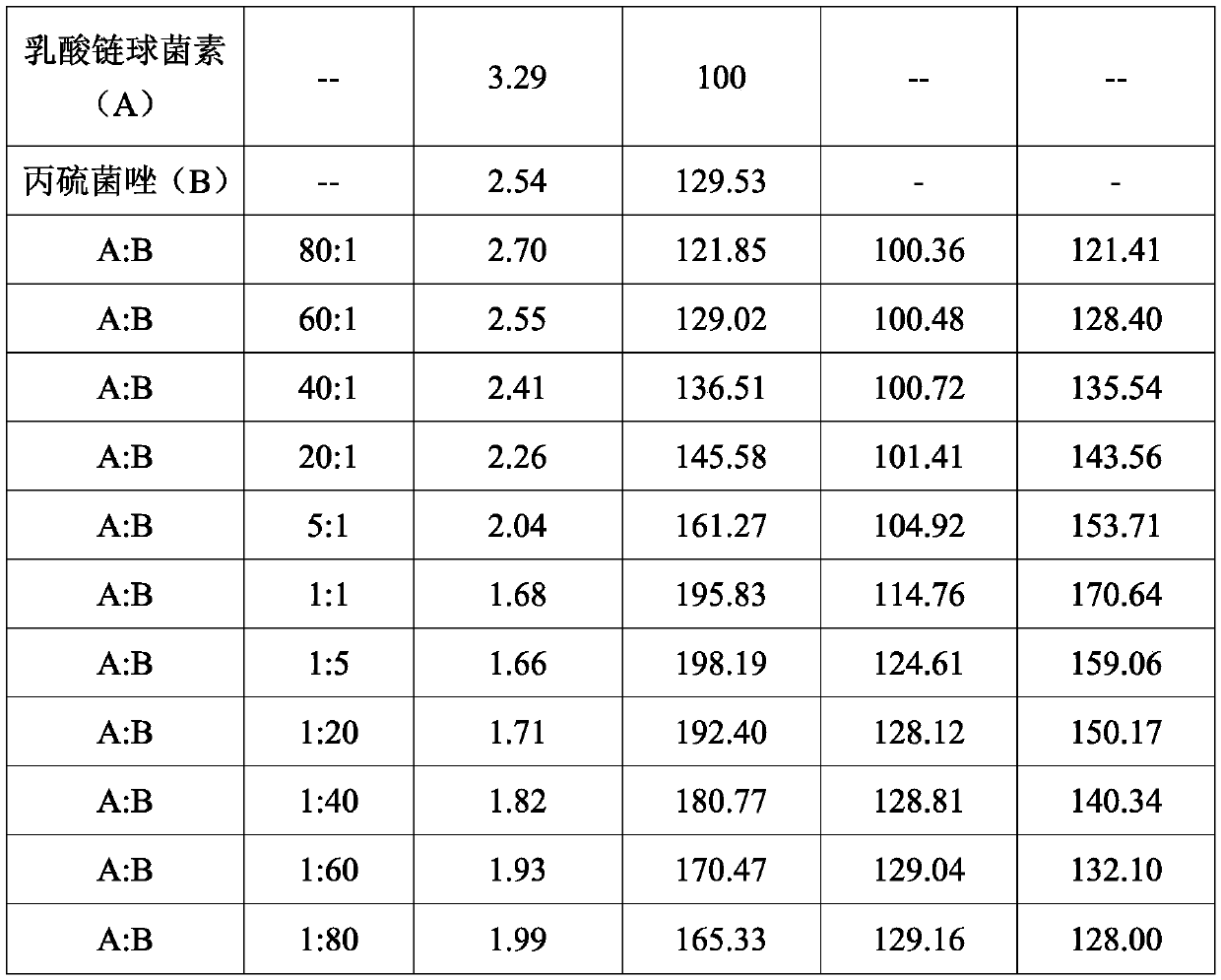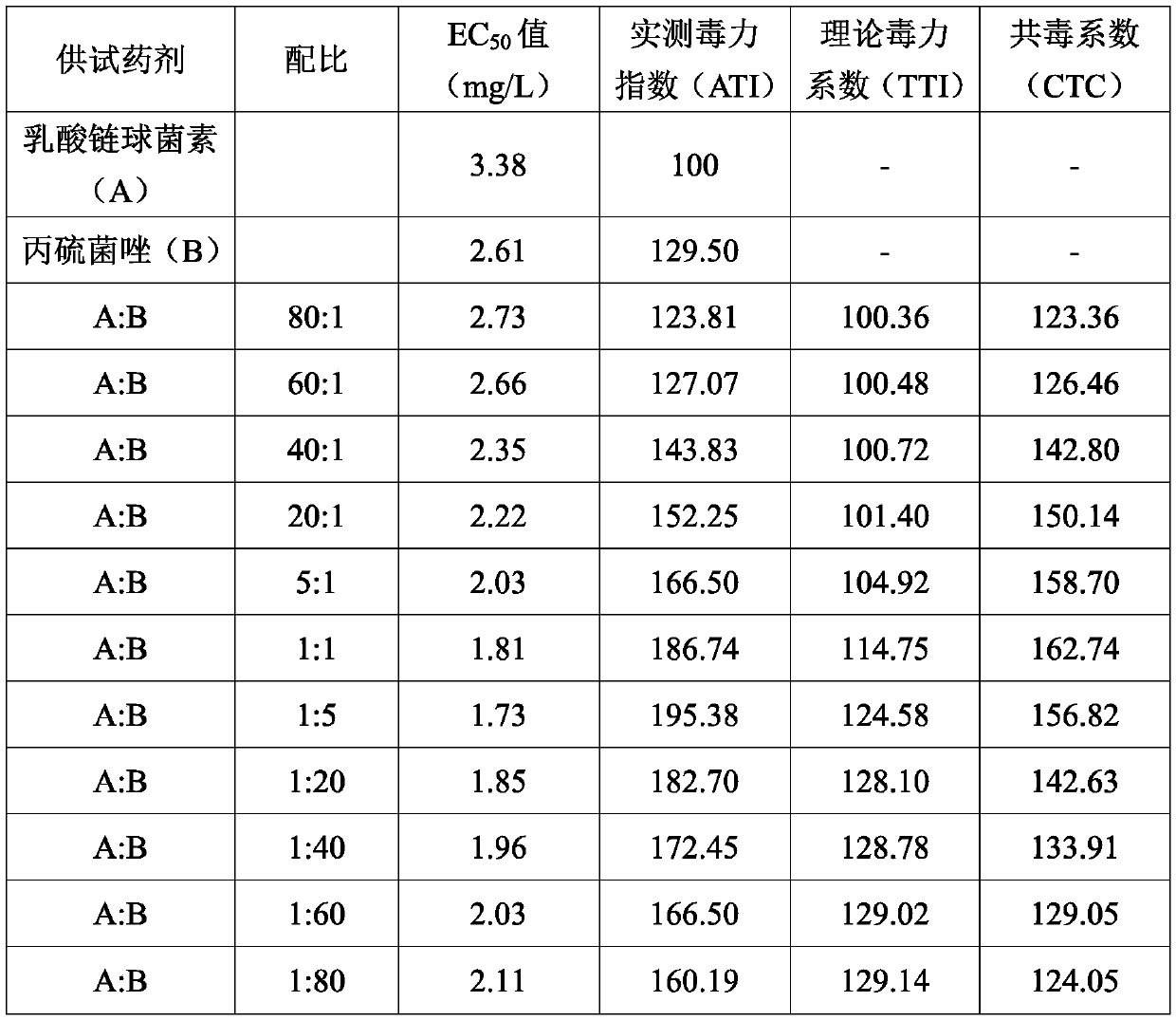Bactericidal composite containing prothioconazole and nisin
A technology of nisin and prothioconazole, which is applied in the direction of fungicides, biocides, biocides, etc., can solve problems such as unsatisfactory control effects, increased resistance of pathogenic bacteria, and difficult disease control, etc., to achieve synergistic growth Obvious effect, long-lasting effect, not easy to resist
- Summary
- Abstract
- Description
- Claims
- Application Information
AI Technical Summary
Problems solved by technology
Method used
Image
Examples
Embodiment 1
[0022] Example 1 Indoor Toxicity Determination of Prothioconazole and Nisin Compounded to Wheat Powdery Mildew
[0023] Determination method of indoor antibacterial effect: The growth rate method is used to determine the inhibitory effect of the fungicidal composition on wheat powdery mildew pathogen. Take 5mm-diameter mycelium blocks from the edge of wheat take-all colonies cultured on PDA medium for 4 days and inoculate them on PDA medium plates containing different concentrations of fungicides, culture at a constant temperature of 28°C, and use the plates without agents as blank As a control, measure the colony diameter of each treatment after 4 days, and calculate the inhibitory percentage of the medicament to mycelial growth. Through the regression analysis of the logarithm of each treatment dose and the probability value of mycelial growth inhibition rate, the inhibitory medium concentration (EC) of the treatment fungicide to wheat powdery mildew was calculated. s0 ), a...
Embodiment 2
[0033] Example 2 Indoor Toxicity Determination of Prothioconazole and Nisin Compound to Wheat Sheath Blight
[0034] Determination method of indoor antibacterial effect: The growth rate method is used to determine the inhibitory effect of the fungicidal composition on wheat sheath blight. Take mycelia pieces with a diameter of 5 mm from the edge of wheat sheath blight colonies cultured on PDA medium for 4 days and inoculate them on PDA medium plates containing different concentrations of fungicides, culture at a constant temperature at 28°C, and use the plates without agents as blank As a control, measure the colony diameter of each treatment after 4 days, and calculate the inhibitory percentage of the medicament to mycelial growth. The logarithm of each treatment dose and the probability value of mycelial growth inhibition rate were used for regression analysis to calculate the inhibitory medium concentration (EC) of fungicides on wheat sheath blight. 50 ), and then calculat...
Embodiment 3
[0043] Example 3 Indoor Toxicity Determination of Prothioconazole and Nisin Compound to Wheat Fusarium Wilt
[0044] Determination method of indoor antibacterial effect: The growth rate method is used to determine the inhibitory effect of the fungicidal composition on wheat Fusarium wilt. Take mycelium blocks with a diameter of 5 mm from the edge of the wheat root rot colony cultured on PDA medium for 4 days and inoculate them on PDA medium plates containing different concentrations of fungicides, and culture them at a constant temperature at 28°C. As a control, measure the colony diameter of each treatment after 4 days, and calculate the inhibitory percentage of the medicament to mycelial growth. Through the regression analysis of the logarithm of each treatment dose and the probability value of mycelial growth inhibition rate, the inhibitory medium concentration (EC) of the treatment fungicide to wheat wilt was calculated. 50 ), and then calculate the co-toxicity coefficien...
PUM
 Login to View More
Login to View More Abstract
Description
Claims
Application Information
 Login to View More
Login to View More - R&D
- Intellectual Property
- Life Sciences
- Materials
- Tech Scout
- Unparalleled Data Quality
- Higher Quality Content
- 60% Fewer Hallucinations
Browse by: Latest US Patents, China's latest patents, Technical Efficacy Thesaurus, Application Domain, Technology Topic, Popular Technical Reports.
© 2025 PatSnap. All rights reserved.Legal|Privacy policy|Modern Slavery Act Transparency Statement|Sitemap|About US| Contact US: help@patsnap.com



